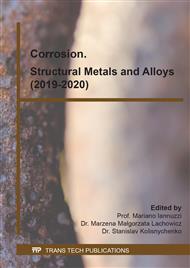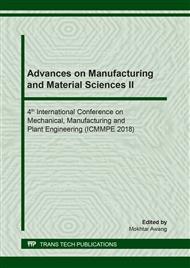[1]
Hosseini A. and Kishawy A.H., in Machining of titanium alloys, J. P. Davim, Ed., Oshawa, 2014, pp.31-54.
Google Scholar
[2]
Sharma A., Sharma M.D. and Sehgal R., Experimental Study of Machining Characteristics of Titanium Alloy (Ti–6Al–4V),, Arab Journal of Science Engineering, Vols. 3201-3209, p.38, (2013).
DOI: 10.1007/s13369-012-0451-7
Google Scholar
[3]
Celik Y.H., Kilickap E. and Guney M., Investigation of cutting parameters affecting on tool wear and surface roughness in dry turning of Ti 6Al 4V using CVD and PVD coated tools,, The brazilian society of mechanical sciences and engineering, (2016).
DOI: 10.1007/s40430-016-0607-6
Google Scholar
[4]
Black J.T., in ASM hand book, Ohio, ASm international, (1989).
Google Scholar
[5]
Sadeghi M.H., Haddad M.J., Tawakoli T. and Emami M., Minimal quantity lubrication-MQL in grinding of Ti-6Al-4V titanium alloy,, International Journal of Advance Manufacturing Technology, vol. 44, pp.487-500, (2009).
DOI: 10.1007/s00170-008-1857-y
Google Scholar
[6]
Myers J.R., Bomberger H. B. andFroes F.H., Corrosion Behavior and Use of titanium and its alloys,, The Journal of The Minerals, Metals & Materials Society, vol. 36, p.50–60, (1984).
Google Scholar
[7]
Rotella G., Dillon O.W., Umbrello J.R.D., Settineri L. and Jawahir I.S., The effects of cooling conditions on surface integrity in machining of Ti6Al4V alloy,, Advance manufacturing Technology, vol. 71, pp.47-55, (2014).
DOI: 10.1007/s00170-013-5477-9
Google Scholar
[8]
Sun F.J., Qu S.G., Pan Y.X., Li X.Q. and Li F.L., Effects of cutting parameters on dry machining Ti-6Al-4V alloy with ultra-hard tools,, International Journal of Advance Manufacturing Technology, vol. 79, p.351–360, (2015).
DOI: 10.1007/s00170-014-6717-3
Google Scholar
[9]
Assis S.L., Wolynec S. and Costa I., Corrosion characterization of titanium alloys by electrochemical techniques,, Electrochimica Acta, vol. 51, p.1815–1819, (2006).
DOI: 10.1016/j.electacta.2005.02.121
Google Scholar
[10]
Che-Haron C.H. and Jawaid A., The effect of machining on surface integrity of titanium alloy Ti–6% Al–4% V,, Journal of Materials Processing Technology, vol. 166, p.188–192, (2005).
DOI: 10.1016/j.jmatprotec.2004.08.012
Google Scholar
[11]
Mousssaoui K., Mousseigne M., Senatore J., Cheiragatti R. and Monies F., Influnce of milling on surface intergrity of Ti-6Al-4V- study of metallurgical characteristics:microstructure and microhardness,, vol. 67, pp.1477-1489, (2012).
DOI: 10.1007/s00170-012-4582-5
Google Scholar
[12]
Dawood A., a study on the sustainable machining of titanium alloy,, Western Kentucky University, Kentucky, (2016).
Google Scholar
[13]
Ibrahim G.A., Cheharon C.H. and Ghani G.A., The Effect of Dry Machining on Surface Integrity of Titanium Alloy Ti-6Al-4V ELI,, Journal of applied sciences, vol. 1, pp.121-127, (2009).
DOI: 10.3923/jas.2009.121.127
Google Scholar
[14]
Weng S., Huang Y.H., Xuan F.Z. and Luo L.H., Correlation between microstructure, hardness and corrosion of welded joints of disc rotors,, in Proceedia engineering, Shanghai, (2015).
DOI: 10.1016/j.proeng.2015.12.325
Google Scholar



